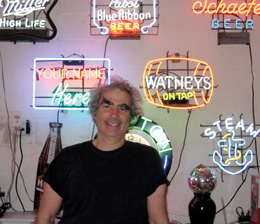Inside his squat Long Island City studio, surrounded by machinery, remnants of art exhibits past and bright signs that read “Watneys on Tap” and “Pabst Blue Ribbon Beer,” Kenny Greenberg ’72 passes a long, thin glass tube through a flame and bends it like a pretzel.
 Kenny Greenberg ’72 in his workshop in Long Island City, Queens.
Photo: Katie Melone ’01J
Kenny Greenberg ’72 in his workshop in Long Island City, Queens.
Photo: Katie Melone ’01J
For decades, Greenberg has worked this highly specialized craft, creating neon signs that have graced Broadway stages, popular television show sets and high-end retail stores.
His work combines elements of science, art, electronics and design. Among his peers, Greenberg’s two-man operation, Krypton Neon, has gained a reputation for high-quality work in a field that has waned as few forefathers of the business passed down their trade. Greenberg, 58, was drawn to the field in his late 20s as a creative outlet when he realized he was unfulfilled in the education field.
While he is a commercial success in design and restoration of neon signs — Greenberg designed neon for the 2009 Tony awards, and for movies such as Men in Black and stores such as Chanel — he still sees his work primarily through the prism of art.
“It’s visual music, really,” he says, standing at his workbench.
And he looks the part of vanguard artist or musician. On this day, he’s wearing a black t-shirt and beat-up black Levis, his hair a mop of salt and pepper curls and his black eyebrows bushy and unkempt. A New Yorker for 30 years, Greenberg moved to Long Island City in 1988, well before it became fashionable.
Greenberg came to neon after a brief stint working in education for the Jewish Child Care Association of New York. Unhappy in his work, he started to read and study matter and energy “from both a physics and metaphysics point of view,” he explained. “And the nature of light plays a strong role in both realms.”
Around 1980, Greenberg’s then-girlfriend noticed an ad for a neon course. It had never occurred to him that humans created neon; he assumed a machine manufactured the signs he admired. “For a bright guy, I wasn’t very bright,” he says, then chuckles. When “I learned it was something that was made by hand, a light bulb lit in my head.”
Greenberg found a haven taking classes at the New York Experimental Glass Workshop, now known as Urban Glass. “I was very lucky,” he says. “I had some very creative people around me.”
Greenberg flourished and eventually set out on his own, founding Krypton Neon, creating the first neon Web site (www. neonshop.com) and settling in his studio in Long Island City. About 10 years ago, he hired his first employee, another neon sign-maker.
“We made glancing contact in the ’80s. I found out he was doing stuff in neon and I seem to recall that, at the time, he was only beginning to go professional, and in my eyes, it was a sideline of his,” recalls Peter Frank ’72, an art critic and friend from Columbia who became a roommate after graduation. “I think he was doing something with kids or adolescents, and I thought that was pretty cool, but I never followed up on it. Next thing you know … he is the leading neon craft person for the design and performing arts in America.”
The son of a chemist and the owner of an employment agency, Greenberg was born in 1950 in Brooklyn. His family lived in Flatbush until he was 11, when they moved to Englewood, N.J.
Greenberg entered Columbia in 1968. “There was all this radical stuff going on,” he says. He vividly remembers a sea of students lining Broadway during a protest. Meanwhile, he played his guitar, drew cartoons on the walls of his dorm (including a satiric take on the inhabitants, he says) and chased girls at Barnard.
“In terms of putting him into a category, he was a sensitive guitar strummer but with a poetic attitude liberally — unusually liberally — leavened with humor,” Frank says.
A mediocre engineering student early on, Greenberg transferred to the College and threw himself into his liberal arts studies, fondly recalling classes with Kenneth Koch, considered one of the great poets of the New York school of poetry, and Stanley Schachter, a noted social psychologist. Greenberg graduated with a B.A. in psychology, and two years later, an M.A. in education and psychology from Teachers College.
Of their time at the school, Frank says, “We knew that it was both a unique opportunity to explore the world and a unique moment in which to do so. And that is the general context for how Kenny found himself gravitating toward this neon art and neon craft.”
Greenburg’s first big show was Miss Saigon. He has since created neon for popular productions such as Victor/Victoria, Saturday Night Fever and Spring Awakening, and the movie Six Degrees of Separation, among others.
The work can be all-consuming. “If I have a day when I’m agitated, there’s a much higher chance that my work will have cracked,” he says. “It’s literally stored what I’ve put into it.”
But he achieves a certain Zen while in his studio. “When I’m working with glass,” he says, “I’m in a nice relaxed state, and I enjoy it.”
Katie Melone ’01J is a freelance journalist in Brooklyn, N.Y.
